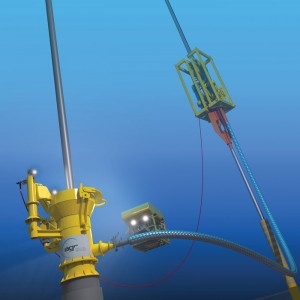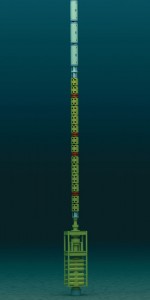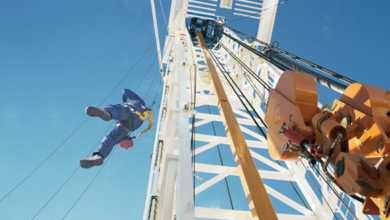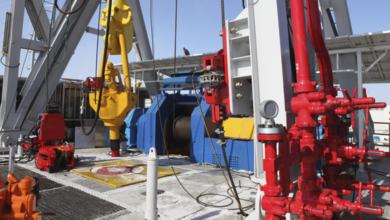Drilling & Completion Tech Digest
Shell, CNPC to develop well manufacturing system
Shell and China National Petroleum Company (CNPC) will establish a joint venture to develop a highly automated well manufacturing system (WMS) to improve the efficiency of drilling and completing new wells onshore. The details of the parties’ respective contributions to the joint venture will be agreed during the transition phase over the coming months. The joint venture, subject to further corporate and government approvals, is 50% CNPC and 50% Shell.
Full-scale commercialisation of tight gas, shale gas and coal bed methane can require the drilling of hundreds of wells. It is intended that the WMS will be designed to drill and complete wells in a standardized and repeatable manner using advanced automation techniques. The system aims to incorporate the best technology and procurement capabilities from both partners.
The joint venture intends to use state-of-the-art technologies, such as automated directional drilling and drilling optimization, including technologies pioneered by Shell in its North America tight-gas operations. The WMS joint venture is expected to source the majority of its rigs, services and drilling equipment from low-cost suppliers in China. This combination could unlock substantial natural gas resources cost-efficiently and on a large scale.
Woodside looks to RMR for hole instability problems

Woodside has signed on with AGR Drilling Services to use its Riserless Mud Recovery system (RMR) for top-hole drilling on an exploration campaign on Australia’s North West Shelf. RMR will be used from the Nanhai VI semi to drill through the Bare Formation of unconsolidated sands, renowned for difficult drilling conditions.
According to AGR, one advantage of RMR is that it allows the use of an engineered mud system to prevent hole instability without discharge to the seabed. This is done by using a subsea pump module to return mud and cuttings from the wellhead back to the rig. The company estimates that the system has the potential to save US$1 million/day in rig days. RMR has been used on more than 140 wells worldwide.
The operator has previously used RMR in the Browse Basin in 2008.
“In the Browse Basin well back in 2008, we helped Woodside achieve a zero-discharge drilling. This time we will help them by making the drilling safer, faster and more environmentally friendly,” Bernt Eikemo, general manager Asia Pacific at AGR, said.
AGR also recently signed an agreement with Statoil to use RMR on two deepwater rigs in the Gulf of Mexico. Statoil previously used RMR in the Gulf from the Discoverer Americas drillship; it was on the Krakatoa well in the Mississippi Canyon block at a depth of more than 620 m (2,000 ft).
The new deal with Statoil will see AGR’s existing technology further enhanced to cope with the increasing water depths faced by Statoil in the Gulf.
RMR is a registered trademark of AGR Drilling Services.
Cotton Valley BHA footage record set with 3,522 ft in 178 hrs
MS Energy Services set a Cotton Valley bottomhole assembly (BHA) drilling footage record on 21 April 2011 while drilling for Devon Energy. The assembly drilled a total of 3,522 ft in 178 hrs, for an average ROP of 20.6 ft/hr. MS Directional provided the directional drilling support, using an Mpact Downhole Motor configured with a 4 ¾-in. slow-speed performance power section and premium stator elastomer.
The well, Bryson A Abney JK Unit 12H, was drilled using rig H&P 396 in Harrison County, Texas. Hole size was 6 ¾, and the bit type used was Security FX64D.
ConocoPhillips to explore in deepwater Bangladesh
ConocoPhillips is kicking off exploration in the virtually unexplored deepwaters of Bangladesh, signing a production sharing contract with the government and Petrobangla covering two blocks in the Bay of Bengal. Blocks DS-08-10 and DS-08-11 cover 5,158 sq km and are located in water depths of 1,000-1,500 meters approximately 280 km from the port city of Chittagong.
Baker Hughes ESP sets run life record offshore Brazil
A Baker Hughes deepwater electrical submersible pump has set a run-life record in the Campos Basin, the company said in May. The ESP, installed at 4,430 ft (1,350 meters) and started in summer 2007, has recorded more than 1,360 days of continuous operation.
Another of the company’s electrical submersible pumps in this area, which started 12 days earlier, is also still running. An umbilical failure unrelated to the pumping system interrupted the continuous operation for this unit.
These deployments beat a previous record of about 1,300 days for a subsea ESP completion in shallower waters.
Riser buoyancy technology helps set ultra-deepwater drilling depth record

Innovative drill riser buoyancy technology helped Transocean to achieve the record depth of 10,194 ft during a drilling job offshore India for Reliance Industries from the ultra-deepwater drillship Dhirubhai Deepwater KG2, Trelleborg Offshore said.
Trelleborg supplied Ultra Module Integrity System (MIS) drill riser buoyancy modules (DRBMs) rated down to 11,000 ft to cover 100 riser joints for the drilling rig. The modules are constructed from low-density composite syntactic foam, which is reinforced with a proprietary sublayer and encased in a glass reinforced epoxy (GRE) external skin.
In addition, 11 joints of stackable riser guard and riser shims were specified. The innovative riser guard is a free-flooding, self-equalizing, neutrally buoyant unit, offering protection for bare riser joints and external lines during handling, storage and drilling operations.
“The drill riser provides a conduit for the drillstring and drilling fluids from the ocean floor to the rig. This has significant weight which must be supported by its own structure and ultimately by the drilling vessel. To reduce this weight in water to a more manageable amount, discrete drill riser buoyancy modules are fitted around the riser circumference along its length,” said Billy Nitsche, drilling global customer solutions manager, Trelleborg Offshore.
Statoil oil sands demo project reaches 1 million bbl mark
Statoil’s Leismer Demonstration Project (LDP) in northern Alberta, Canada, has achieved a production milestone of one million accumulated barrels of oil.
First oil at LDP was achieved in January 2011 and is expected to ramp up to its rated capacity of 18,800 bbl/day within 24 months.
Statoil’s Kai Kos Deh Seh project includes four oil sands leases in the Athabasca region of Northeast Alberta: Leismer, Corner, Hangingstone and Thornberry.
Halliburton sets world record with deepest TAML Level 4 multilateral junction
Halliburton has installed the deepest TAML Level 4 cemented multilateral junction in the world for PetroChina’s Tarim Oilfield Company (TOC) in a remote onshore well in the Xinjiang province of Northwest China, doubling reservoir exposure, increasing production and reducing drilling and completions costs. TAML classifications were established by the group Technology Advancement for Multi-Laterals.
Halliburton applied engineering expertise during planning and execution to overcome the technical challenges associated with creating this milled casing exit with a cemented multilateral junction. TOC now regards multilateral technology as a solution for additional wells of the same nature, possibly with more than one junction per well.
Halliburton believes the multilateral technology installed for TOC is also a solution for shale plays because it enables operators to maximize production without drilling additional new wells.
Multilateral technology was once believed to be for only mature fields to maximize production. But today the technology is being applied much earlier in the development phase, driving improved economics for shale gas and deep water, where maximizing production is often difficult with conventional drilling methods.
For TOC, Halliburton created the TAML Level 4 multilateral junction at 5,089 meters (16,696 ft) measured depth in the vertical section of the 7-in., 29-lb/ft weight liner. The main and lateral wellbores were cased and cemented, with both bores cemented at the junction.
Halliburton holds world records in both the deepest junction and the deepest cemented junction installations. Please see Page 90 for more detailed information on the latest industry advances in multilateral completions.



